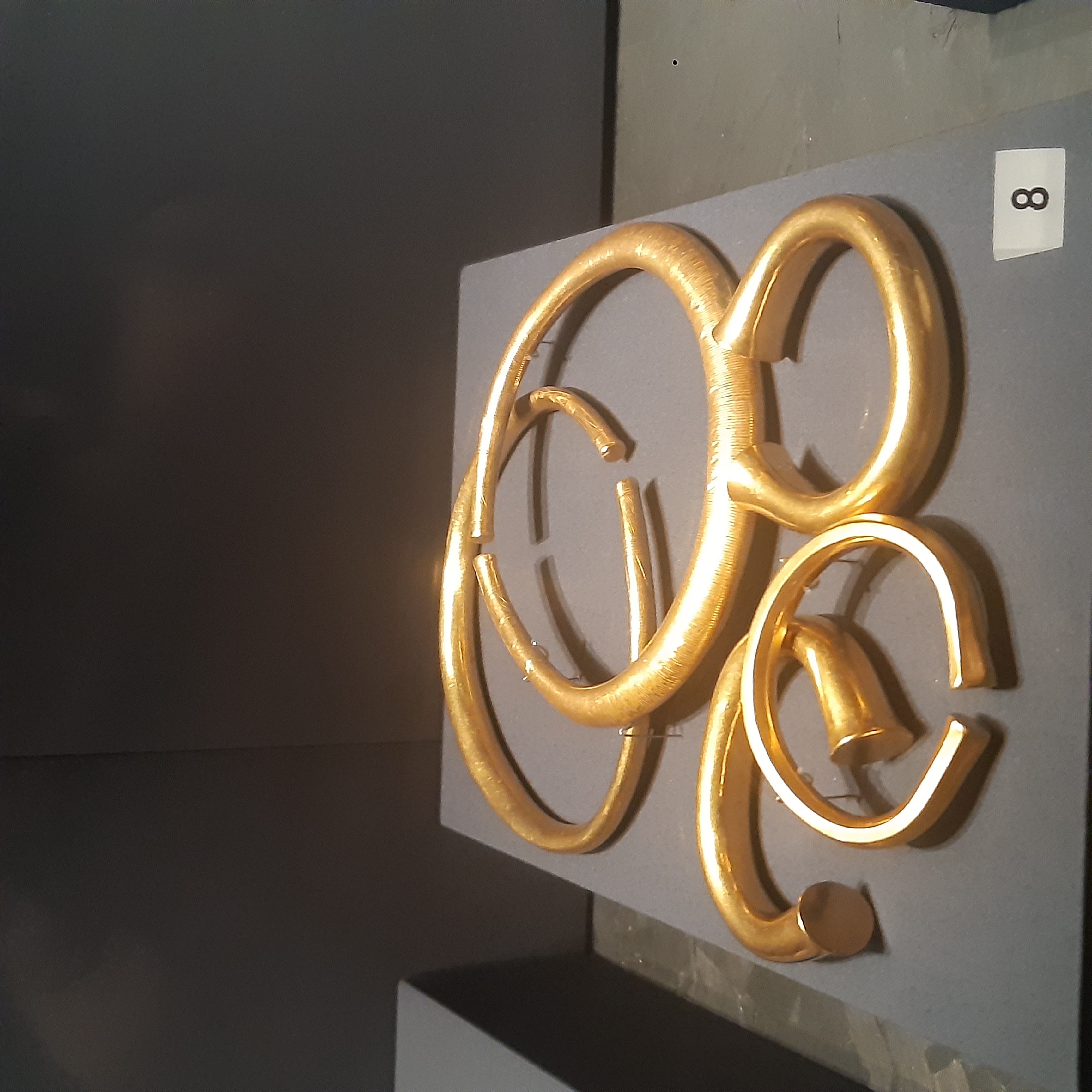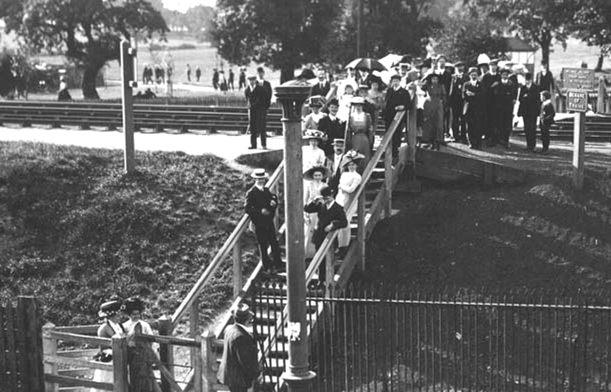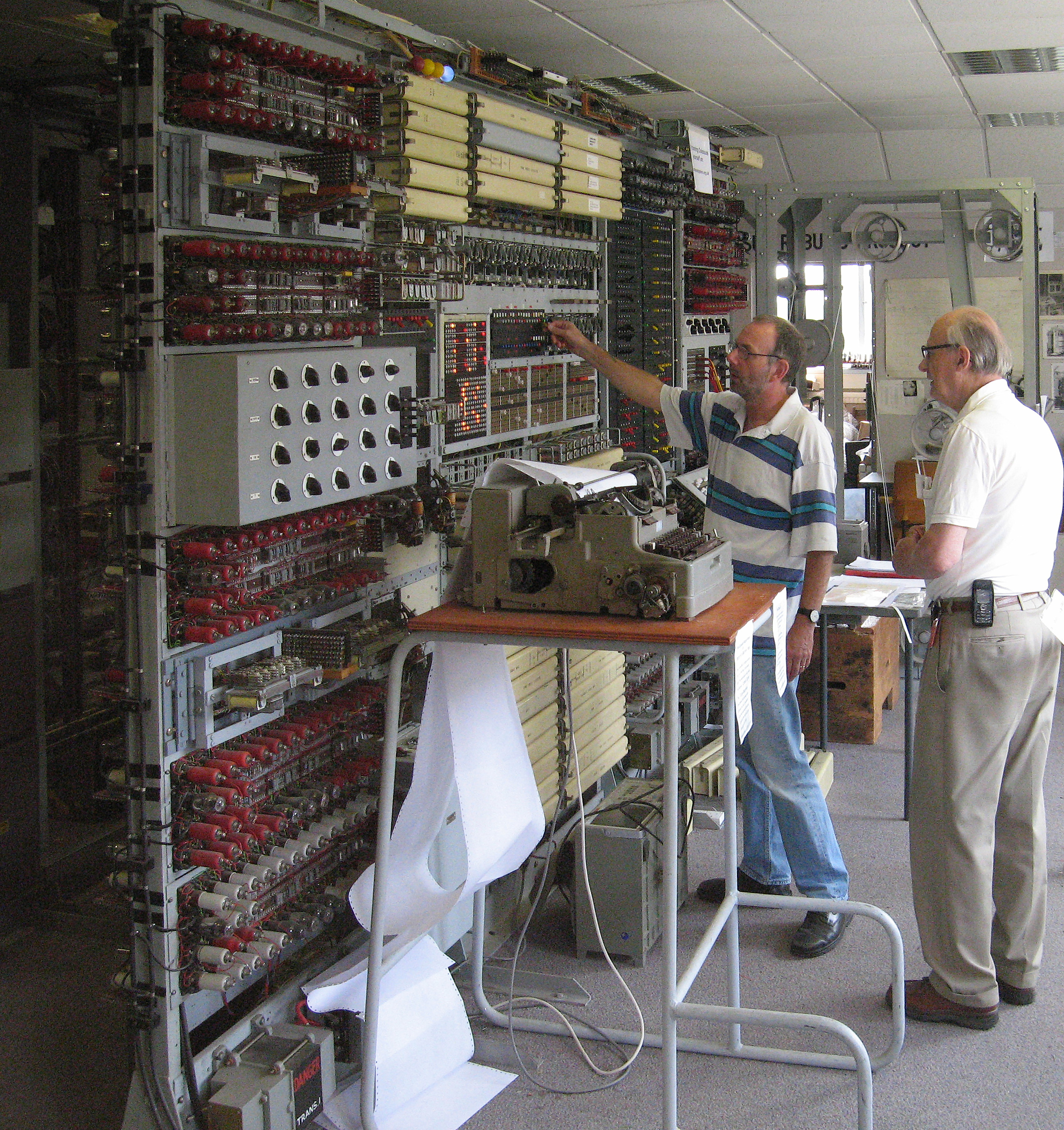|
Bletchley Park
Bletchley Park is an English country house and estate in Bletchley, Milton Keynes ( Buckinghamshire) that became the principal centre of Allied code-breaking during the Second World War. The mansion was constructed during the years following 1883 for the financier and politician Sir Herbert Leon in the Victorian Gothic, Tudor, and Dutch Baroque styles, on the site of older buildings of the same name. During World War II, the estate housed the Government Code and Cypher School (GC&CS), which regularly penetrated the secret communications of the Axis Powersmost importantly the German Enigma and Lorenz ciphers. The GC&CS team of codebreakers included Alan Turing, Gordon Welchman, Hugh Alexander, Bill Tutte, and Stuart Milner-Barry. The nature of the work at Bletchley remained secret until many years after the war. According to the official historian of British Intelligence, the "Ultra" intelligence produced at Bletchley shortened the war by two to four years, and without it th ... [...More Info...] [...Related Items...] OR: [Wikipedia] [Google] [Baidu] |
Milton Keynes
Milton Keynes ( ) is a city and the largest settlement in Buckinghamshire, England, about north-west of London. At the 2021 Census, the population of its urban area was over . The River Great Ouse forms its northern boundary; a tributary, the River Ouzel, meanders through its linear parks and balancing lakes. Approximately 25% of the urban area is parkland or woodland and includes two Sites of Special Scientific Interest (SSSIs). In the 1960s, the UK government decided that a further generation of new towns in the South East of England was needed to relieve housing congestion in London. This new town (in planning documents, 'new city'), Milton Keynes, was to be the biggest yet, with a target population of 250,000 and a 'designated area' of about . At designation, its area incorporated the existing towns of Bletchley, Fenny Stratford, Wolverton and Stony Stratford, along with another fifteen villages and farmland in between. These settlements had an extensive historical ... [...More Info...] [...Related Items...] OR: [Wikipedia] [Google] [Baidu] |
Bombe
The bombe () was an electro-mechanical device used by British cryptologists to help decipher German Enigma-machine-encrypted secret messages during World War II. The US Navy and US Army later produced their own machines to the same functional specification, albeit engineered differently both from each other and from Polish and British bombes. The British bombe was developed from a device known as the " bomba" ( pl, bomba kryptologiczna), which had been designed in Poland at the Biuro Szyfrów (Cipher Bureau) by cryptologist Marian Rejewski, who had been breaking German Enigma messages for the previous seven years, using it and earlier machines. The initial design of the British bombe was produced in 1939 at the UK Government Code and Cypher School (GC&CS) at Bletchley Park by Alan Turing, with an important refinement devised in 1940 by Gordon Welchman. The engineering design and construction was the work of Harold Keen of the British Tabulating Machine Company. The first bo ... [...More Info...] [...Related Items...] OR: [Wikipedia] [Google] [Baidu] |
Ultra
adopted by British military intelligence in June 1941 for wartime signals intelligence obtained by breaking high-level encrypted enemy radio and teleprinter communications at the Government Code and Cypher School (GC&CS) at Bletchley Park. ''Ultra'' eventually became the standard designation among the western Allies for all such intelligence. The name arose because the intelligence obtained was considered more important than that designated by the highest British security classification then used (''Most Secret'') and so was regarded as being ''Ultra Secret''. Several other cryptonyms had been used for such intelligence. The code name ''Boniface'' was used as a cover name for ''Ultra''. In order to ensure that the successful code-breaking did not become apparent to the Germans, British intelligence created a fictional MI6 master spy, Boniface, who controlled a fictional series of agents throughout Germany. Information obtained through code-breaking was often attributed to the ... [...More Info...] [...Related Items...] OR: [Wikipedia] [Google] [Baidu] |
Bletchley
Bletchley is a constituent town of Milton Keynes, Buckinghamshire, England. It is situated in the south-west of Milton Keynes, and is split between the civil parishes of Bletchley and Fenny Stratford and West Bletchley. Bletchley is best known for Bletchley Park, the headquarters of Britain's World War II codebreaking organisation, and now a major tourist attraction. The National Museum of Computing is also located on the Park. History Origins and early modern history The town name is Anglo-Saxon and means ''Blæcca's clearing''. It was first recorded in manorial rolls in the 12th century as ''Bicchelai'', then later as ''Blechelegh'' (13th century) and ''Blecheley'' (14th–16th centuries). Just to the south of Fenny Stratford, there was Romano-British town, '' M'' on either side of Watling Street, a Roman road. Bletchley was originally a minor village on the outskirts of Fenny Stratford, of lesser importance than Water Eaton. Fenny Stratford fell into decline from the Engl ... [...More Info...] [...Related Items...] OR: [Wikipedia] [Google] [Baidu] |
Domesday Book
Domesday Book () – the Middle English spelling of "Doomsday Book" – is a manuscript record of the "Great Survey" of much of England and parts of Wales completed in 1086 by order of King William I, known as William the Conqueror. The manuscript was originally known by the Latin name ''Liber de Wintonia'', meaning "Book of Winchester", where it was originally kept in the royal treasury. The '' Anglo-Saxon Chronicle'' states that in 1085 the king sent his agents to survey every shire in England, to list his holdings and dues owed to him. Written in Medieval Latin, it was highly abbreviated and included some vernacular native terms without Latin equivalents. The survey's main purpose was to record the annual value of every piece of landed property to its lord, and the resources in land, manpower, and livestock from which the value derived. The name "Domesday Book" came into use in the 12th century. Richard FitzNeal wrote in the ''Dialogus de Scaccario'' ( 1179) that the book ... [...More Info...] [...Related Items...] OR: [Wikipedia] [Google] [Baidu] |
The National Museum Of Computing
The National Museum of Computing is a museum in the United Kingdom dedicated to collecting and restoring historic computer systems. The museum is based in rented premises at Bletchley Park in Milton Keynes, Buckinghamshire and opened in 2007. The building — ''Block H'' — was the first purpose-built computer centre in the world, hosting six Colossus computers by the end of World War II. The museum houses a rebuilt Mark 2 Colossus computer alongside an exhibition of the most complex code cracking activities performed at the Park, along with examples of machines continuing the history of the development of computing from the 1940s to the present day. The museum has a policy of having as many of the exhibits as possible in full working order. Although located on the Bletchley Park "campus", The National Museum of Computing is an entirely separate registered charity with its own fund-raising and separate entrance/ticketing. TNMOC receives no public funding and relies on the ge ... [...More Info...] [...Related Items...] OR: [Wikipedia] [Google] [Baidu] |
Max Newman
Maxwell Herman Alexander Newman, FRS, (7 February 1897 – 22 February 1984), generally known as Max Newman, was a British mathematician and codebreaker. His work in World War II led to the construction of Colossus, the world's first operational, programmable electronic computer, and he established the Royal Society Computing Machine Laboratory at the University of Manchester, which produced the world's first working, stored-program electronic computer in 1948, the Manchester Baby. Education and early life Newman was born Maxwell Herman Alexander Neumann in Chelsea, London, England, to a Jewish family, on 7 February 1897. His father was Herman Alexander Neumann, originally from the German city of Bromberg (now in Poland), who had emigrated with his family to London at the age of 15.William Newman, "Max Newman – Mathematician, Codebreaker and Computer Pioneer", pp. 176–188 in Herman worked as a secretary in a company, and married Sarah Ann Pike, an Irish schoolteacher, ... [...More Info...] [...Related Items...] OR: [Wikipedia] [Google] [Baidu] |
Dollis Hill
Dollis Hill is an area in northwest London, which consists of the streets surrounding the 35 hectares (86 acres) Gladstone Park. It is served by a London Underground station, Dollis Hill, on the Jubilee line, providing good links to central London. It is in the London Borough of Brent, close to Willesden Green, Neasden and Cricklewood, and is in the postal districts of NW2 and NW10. The area is mainly residential (Edwardian terraced and 1920s/30s semi-detached houses) with a restaurant, greengrocer and convenience stores near the underground station. The Dollis Hill ward has the highest Irish population in London. Dollis Hill played a part in the Second World War as the code-breaking computer used at Bletchley Park was built at the Post Office Research Station in Dollis Hill and the rarely used alternative Cabinet War Room bunker for Winston Churchill's government was dug underground here. History The Dollis Hill Estate was formed in the early 19th century, when the ... [...More Info...] [...Related Items...] OR: [Wikipedia] [Google] [Baidu] |
Post Office Research Station
The Post Office Research Station was first established as a separate section of the General Post Office in 1909. In 1921, the Research Station moved to Dollis Hill, north west London, initially in ex-army huts. The main permanent buildings at Dollis Hill were opened in 1933 by Prime Minister Ramsay MacDonald. In 1968 it was announced that the station would be relocated to a new centre to be built at Martlesham Heath in Suffolk. This was formally opened on 21 November 1975 by Queen Elizabeth and is today known as Adastral Park. The old Dollis Hill site was released for housing, with the main building converted into a block of luxury flats and an access road named Flowers Close, in honour of Tommy Flowers. Much of the rest of the site contains affordable housing administered by Network Housing. Paddock, a World War II concrete two-level underground bunker, was built in secret in 1939 as an alternative Cabinet War Room underneath a corner of the Dollis Hill site. Its surface ... [...More Info...] [...Related Items...] OR: [Wikipedia] [Google] [Baidu] |
Tommy Flowers
Thomas Harold Flowers MBE (22 December 1905 – 28 October 1998) was an English engineer with the British General Post Office. During World War II, Flowers designed and built Colossus, the world's first programmable electronic computer, to help decipher encrypted German messages. Early life Flowers was born at 160 Abbott Road, Poplar in London's East End on 22 December 1905, the son of a bricklayer. Whilst undertaking an apprenticeship in mechanical engineering at the Royal Arsenal, Woolwich, he took evening classes at the University of London to earn a degree in electrical engineering. In 1926, he joined the telecommunications branch of the General Post Office (GPO), moving to work at the Post Office Research Station at Dollis Hill in north-west London in 1930. In 1935, he married Eileen Margaret Green and the couple later had two children, John and Kenneth. From 1935 onward, he explored the use of electronics for telephone exchanges and by 1939, he was convinced that an all- ... [...More Info...] [...Related Items...] OR: [Wikipedia] [Google] [Baidu] |
Colossus Computer
Colossus was a set of computers developed by British codebreakers in the years 1943–1945 to help in the cryptanalysis of the Lorenz cipher. Colossus used thermionic valves (vacuum tubes) to perform Boolean and counting operations. Colossus is thus regarded as the world's first programmable, electronic, digital computer, although it was programmed by switches and plugs and not by a stored program. Colossus was designed by General Post Office (GPO) research telephone engineer Tommy Flowers to solve a problem posed by mathematician Max Newman at the Government Code and Cypher School (GC&CS) at Bletchley Park. Alan Turing's use of probability in cryptanalysis (see Banburismus) contributed to its design. It has sometimes been erroneously stated that Turing designed Colossus to aid the cryptanalysis of the Enigma. (Turing's machine that helped decode Enigma was the electromechanical Bombe, not Colossus.) The prototype, Colossus Mark 1, was shown to be working in December 1943 ... [...More Info...] [...Related Items...] OR: [Wikipedia] [Google] [Baidu] |
British Intelligence
The Government of the United Kingdom maintains intelligence agencies within three government departments, the Foreign Office, the Home Office and the Ministry of Defence. These agencies are responsible for collecting and analysing foreign and domestic intelligence, providing military intelligence, and performing espionage and counter-espionage. Their intelligence assessments contribute to the conduct of the foreign relations of the United Kingdom, maintaining the national security of the United Kingdom, military planning and law enforcement in the United Kingdom. The four main agencies are the Secret Intelligence Service (SIS or MI6), the Security Service (MI5), the Government Communications Headquarters (GCHQ) and Defence Intelligence (DI). The history of the organisations dates back to the 19th century. The decryption of the Zimmermann Telegram in 1917 was described as the most significant intelligence triumph for Britain during World War I, and one of the earliest occasions ... [...More Info...] [...Related Items...] OR: [Wikipedia] [Google] [Baidu] |








